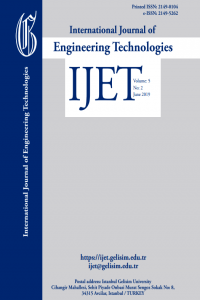A Case Study for Estimation of Heating Energy Requirement and Fuel Consumption in a Prototype Building Using Degree-Day Method in Kocaeli
Energy is a requirement of all industrialised nations, and variations in its availability can be dangerous and disruptive. The majority of the energy consumed in buildings is spent for heating and cooling to ensure the thermal comfort of human beings in all parts of the world. Energy analysis plays a vitally important in the design of heating, ventilation and air conditioning (HVAC) systems at affordable and efficient cost in residential areas. Buildings are in need of heating in cold weather. The mean daily outside air temperature is an important guide in predicting the amount of fuel needed to heat residential buildings. The amount of fuel required to heat an area, a city or a region can be accurately forecasted based on the outside air temperature. One of the well-accepted methods internationally is the heating degree-day (HDD) method, which is employed for the energy analysis. This paper considers for İzmit, the capital district of Kocaeli province, which is located on the western coast of Turkey and aims to calculate the annual heating energy requirement and natural gas consumption at a base temperature of 15oC by considering different type of glass, glazing area percentage (GAP), air exchange rate (ACH), and the number of people (n) living in a prototype building. It was predicted that in the worst condition (single-glazing), natural gas consumption would be about fourfold higher than the best condition (triple-glazing) if it is thought that 60 people live in an apartment building.
Keywords:
heating degree-day, heating energy requirement, natural gas consumption, prototype building Energy analysis,
___
- K. Bilen, O. Ozyurt, K. Bakirci, S. Karsli, S. Erdogan, M. Yilmaz & O. Comakli, "Energy production, consumption, and environmental pollution for sustainable development: A case study in Turkey ", Renewable and Sustainable Energy Reviews, vol. 12, pp. 1529-1561, 2008.
- T. Covert, M. Greenstone & C. R. Knittel, "Will we ever stop using fossil fuels?", The Journal of Economic Perspectives, vol. 30, pp. 117-137, 2016.
- E. Akyuz, "Turkey's energy profile and the importance of renewable energy sources." Academic Sight, vol. 49, pp. 494-504, 2015.
- M. Kadioglu & Z. Sen, "Degree-day formulations and application in Turkey", Journal of Applied Meteorology, vol. 36, pp. 837-846, 1999.
- O. Kaynakli, "A review of the economical and optimum thermal insulation thickness for building applications", Renewable and Sustainable Energy Reviews, vol. 16, pp. 415-425, 2012.
- A. K. Dagsoz & K. G. Bayraktar, "The number of degree-day in Turkey and energy politics", Journal of Sanitary Engineering, pp. 32-40, 1999.
- A. Arisoy, İklim Verileri, III. Uluslar arası Yapıda Tesisat Bilimi ve Teknolojisi Sempozyumu, 1998.
- A. Durmayaz, M. Kadioglu & Z. Sen, "An application of the degree-hours method to estimate the residential heating energy requirement and fuel consumption in Istanbul", Energy, vol. 25, pp. 1245-1256, 2000.
- A. K. Dagsoz, "Degree Day Values in Turkey, National energy saving policy, Heat insulation in buildings", Istanbul: Izocam, 1995.
- H. Sarak & A. Satman, "The degree-day method to estimate the residential heating natural gas consumption in Turkey: a case study", Energy, vol. 28, pp. 929-939, 2003.
- S. Akbayir, "Derece gün metodu ve Eskişehir için derece gün değerlerinin tespiti, Yüksek lisans tezi, O.G.Ü, 2006.
- O. Kaynakli, "A study on residential heating energy requirement and optimum insulation thickness", Renewable Energy, vol. 33, pp. 1164-1172, 2008.
- A. Durmayaz & M. Kadioglu, "Heating energy requirements and fuel consumptions in the biggest city centers of Turkey", Energy Conversion and Management, vol. 44, pp. 1177-1192, 2003.
- A. F. Emery & C. J. Kippenhan, "A long term study of residential home heating consumption and the effect of occupant behavior on homes in the Pacific Northwest constructed according to improved thermal standards", Energy, vol. 31, pp. 677-693, 2006.
- J. F. Kreider & A. Rabl, "Heating and cooling of buildings: design for efficiency McGraw-Hill", New York, 1994.
- S. Usta, "TS 825 “Binalarda Isı Yalıtım Kuralları” Standardına Göre İkinci Bölgede Bulunan Bir Binanın Yalıtımsız ve Yalıtımlı Durumlarının Enerji Verimliliği Bakımından Karşılaştırılması." Electronic Journal of ConstructionTechnologies, vol. 5, pp. 1-24, 2009.
- ASHRAE Handbook Fundamentals, "American society of heating, refrigerating and air-conditioning engineers", Inc. , 2009.
- A. Satman & N. Yalcinkaya, "Heating and cooling degree-hours for Turkey", Energy, vol. 24, pp. 833-840, 1999.
- J. A. Duffie & W. A. Beckman, "Solar engineering of thermal processes", John Wiley & Sons, 2013.
- ISSN: 2149-0104
- Başlangıç: 2015
- Yayıncı: İstanbul Gelişim Üniversitesi
